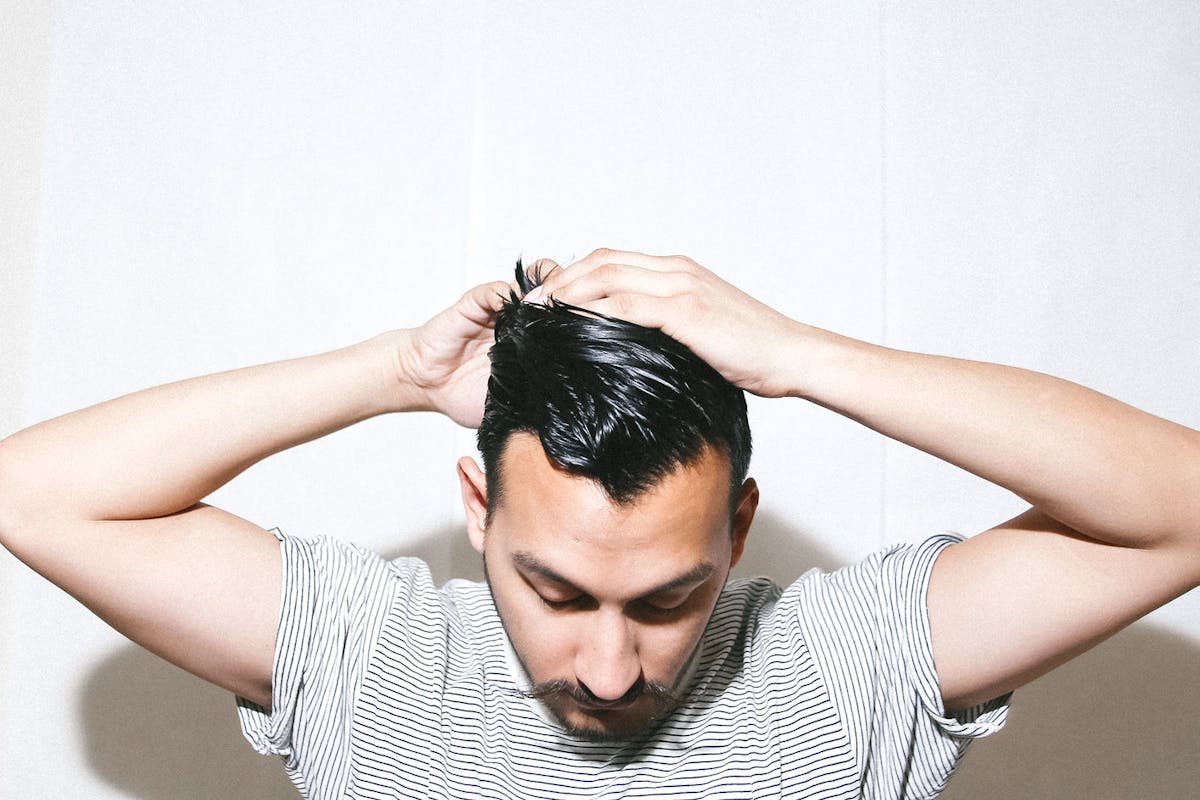If you’ve noticed your hairline is starting to recede, you might be worried that you’re balding or have male pattern baldness. And while your assumption could be correct, a high hairline can mean something else entirely. Your hairline starting to move back can actually be a sign of a mature hairline, not balding.
How To Handle A Mature Hairline
11 Min Read

Get hair, health, and science news delivered right to your inbox.
What is a mature hairline?
Let’s start with understanding what a hairline is. Your hairline is the edge of your hair, usually on the forehead, that outlines where your hair is. There are many types of hairlines, and the shape and location on the scalp depend on many different things such as genetics and age. Age causes a mature hairline.
When men are in their teens, they typically have a full head of hair and what is called a “juvenile hairline.” To find your juvenile hairline, wrinkle your forehead. If your hair is on the top wrinkle, you still have a young or juvenile hairline. Other defining characteristics of a juvenile hairline are the rounded corners and straight-across shape. About 5% of Caucasian men will keep their juvenile hairline their entire lives.
Most men won’t keep their young hairline, though. Instead, usually between the ages 17 and 30, most men will develop a mature hairline, a sign of getting older. A mature hairline occurs when the hairline moves back about a half inch to one inch from where it used to be. That’s all it is. A mature hairline is a completely natural occurrence for most men and not something to worry about.
Characteristics of maturing hairlines
Not all hairlines mature the same, just as all men don’t mature the same. Mature hairlines can occur gradually — to the point that it’s not even noticeable. Some men find it takes 10 years for their hairline to fully mature. On the other hand, some men might find their hairline receding more rapidly, and that’s why some worry it might be male-pattern baldness. Rapid recession can be a sign of a receding hairline, too. Luckily, there are some other characteristics of mature hairlines that set them apart from male-pattern baldness.
- The hairline usually moves back evenly. Though some men will experience an uneven transition to a mature hairline, most will find their hairline moves evenly over time.
- The hairline is only about one to 1.5 inches above your highest wrinkle. This is typically as far as a mature hairline will recede. If your hairline is about the width of your finger above the top wrinkle, you probably have a mature hairline. If it’s receding onto your scalp, it may mean balding.
- The shape is an M or a widow’s peak. An M-shaped hairline removes the round curves of the young hairline and makes a more defined hairline. Frequently, the hairline might create a widow’s peak. A widow’s peak is when there is a V of hair that remains farther down while the hair alongside it recedes more.
Maturing hairline vs. receding hairline
Maturing hairlines and receding hairlines—usually caused by male-pattern baldness—can often start very similarly, so it can be difficult to tell which is causing your hair loss. There are some things that set them apart that can be useful in identifying if your hairline is receding.
- Excessive hair shedding. While there is some hair loss with a maturing hairline, a receding hairline will have clumps of hair coming out, usually when showering or styling. It’s normal to lose 100 hairs a day, but if you’re losing more than that, you may be starting to bald.
- Extra recession on your temples. While a mature hairline does form an M, it’s usually not extremely pronounced. Even if your entire hairline is moving back, if you notice the areas around your temples moving even more, it may be a sign of balding.
- Small hairs beyond your hairline. While everyone has some smaller hairs in front of their hairline, a large amount of light, short hairs in front could mean you’re balding.
If you’re still unsure if your receding hairline is balding or maturing, or if you have other questions, you can check with a doctor. Doctors are able to view the hairs under a microscope to see what is causing your hairline to recede. They’ll also be able to tell if your receding hairline is male pattern baldness.
Dealing with a mature hairline
If you determine that you have a maturing hairline, there can still be some difficulties. Your hairline is an inch farther back after all. Some men have difficulty achieving their normal styles or feeling satisfied with their hair. Here are some tips on how to handle a mature hairline.
- Remember that a mature hairline is completely normal. Almost 96% of men will experience this, so you’re not alone.
- If your receding hair is a mature hairline, then you’re not going bald. The majority of hair specialists all agree that maturing hairlines are not balding hairlines, despite the loss. Also, developing a mature hairline is not a sign that you will go bald later. Some men will keep their mature hairline well into old age.
- Mature hairlines look good. Just because it’s not the hair volume you’re used to doesn’t mean it’s not a good look. It will take some time to get used to your new hairline, but you can grow to love it.
- Embrace the mature hairline styles. Maybe you’ve never tried these styles, but slicking it back, parting it on the side, keeping it messy, or trying the “David Beckham” can all help you feel more confident with your new hairline.
Frequently, men have questions about their hairlines. If you’re worried your hair loss might be male pattern baldness, check with your doctor. But remember that a mature hairline is a natural and normal process that happens to most men. It’s nothing to worry about.